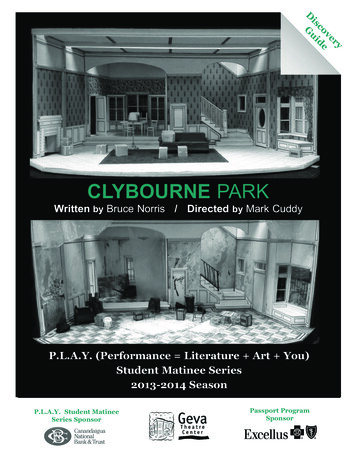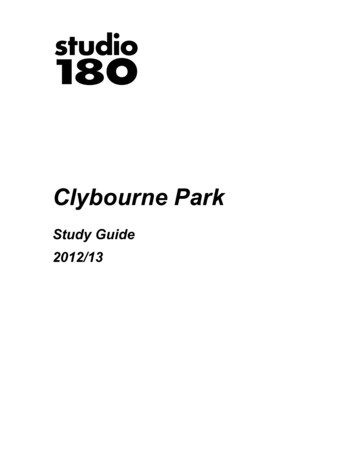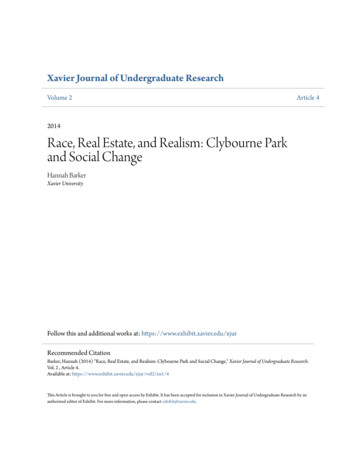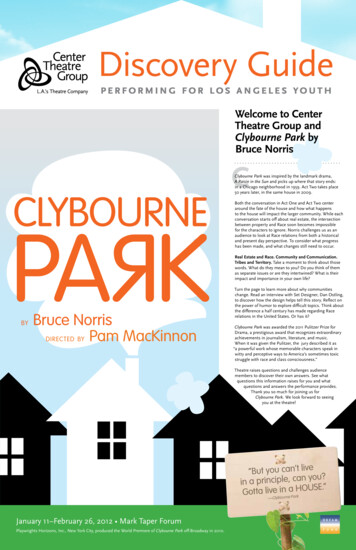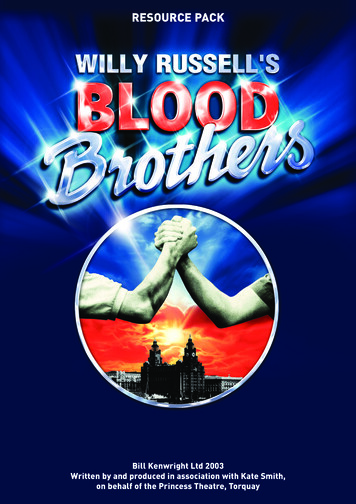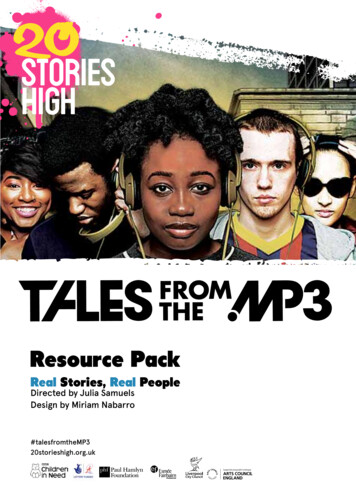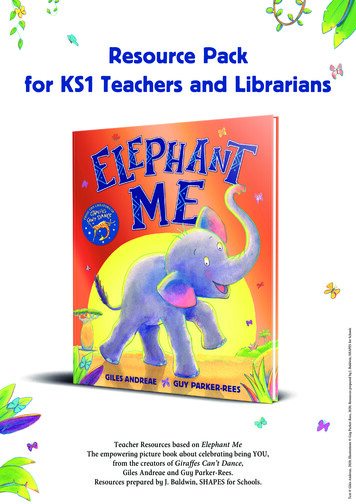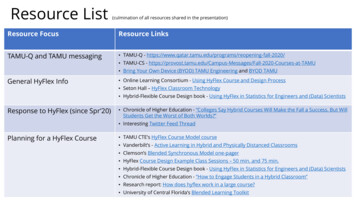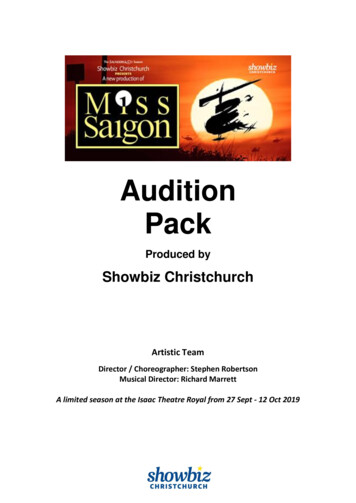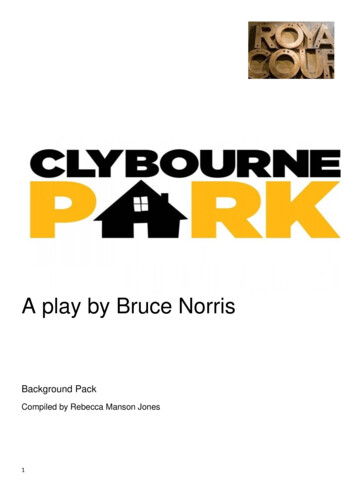
Transcription
A play by Bruce NorrisBackground PackCompiled by Rebecca Manson Jones1
WELCOMEWelcome to the Background Pack to accompany the production of Clybourne Park by Bruce Norris. We hope you find it usefulboth for preparing your students for their visit to the production at the Wyndham’s Theatre and for your discussions andpractical work afterwards. The pack contains information about the production, the context of the play, and some suggestionsfor practical exercises. These can be used for drama, literature, citizenship, history and geography sessions. There are alsofurther action links to encourage students to make connections with other plays and literature which treat similar ideas to thoseexplored in Clybourne Park.Following critical acclaim and a sell out run, Bruce Norris’ satirical comedy Clybourne Park transfers from the Jerwood TheatreDownstairs at the Royal Court to the Wyndham’s Theatre in the West End. Clybourne Park is the latest transfer from the RoyalCourt, after successes with both ENRON and Jerusalem in 2010.In 1959 Russ and Bev are selling their desirable two-bed at a knock-down price. This enables the first Black family to moveinto the neighbourhood, creating ripples of discontent amongst the cosy white urbanites of Clybourne Park. In 2009, the sameproperty is being bought by Lindsey and Steve whose plans to raze the house and start again is met with a similar response.Are the issues festering beneath the floorboards actually the same fifty years on?The production contains explicit language with sexual and racist references . This pack has avoided that wherever possiblebut you should make your students aware that Bruce Norris has chosen consciously to explore and challenge racist and sexistattitudes and in order to do that, asks the audience to confront some uncomfortable truths about the way people used to liveand still think.Clybourne Park was first produced on Broadway in 2009 and was first produced in the UK in 2010 at the Royal Court directedby Artistic Director, Dominic Cooke. The play received a number of awards including the Evening Standard Award and it hasbeen revived and transferred to for a West End run in 2011.‘Genius.’ The Times‘Norris’s play nails the thorny subject of race relations with a bilious zest that takes one’s breath away.’GuardianBruce Norris’ hilarious play explores the fault line between race and property.Director Dominic Cooke’s recent Royal Court credits include Aunt Dan and Lemon, The Fever, Seven Jewish Children, Wig Out!,Now or Later and The Pain and the Itch.Contains very strong languageRunning time 2hrs 10mins including one intervalProduced by Royal Court Theatre Productions, Sonia Friedman Productions and Old Vic Productions.CONTENTS – page nos finalised by RCProduction creditsBruce NorrisSynopsisWho’s who – offstageWho’s Who – onstageDesign2Context/BackgroundRehearsal NotesExercises & DiscussionFurther ActionMore about the Royal Court
All quotes are from the published text Clybourne Park by Bruce Norris, Nick Hern Books with kind permission of the author.3
PRODUCTION CREDITSProduced by the Royal Court Theatre with Old VicProductions and Sonia Friedman ProductionsCASTRuss / DanBev / KathyFrancine / LenaJim / TomAlbert / KevinKarl/SteveBetsey / LindseyKennethStuart McQuarrieSophie ThompsonLorna BrownSam SpruellLucian MsamatiStephen Campbell MooreSarah GoldbergMichael GoldsmithCREATIVE TEAMWriterDirectorDesignerLighting DesignerSound DesignerAssociate Lighting DesignerAssistant DirectorBruce NorrisDominic CookeRobert Innes-HopkinsPaule ConstableDavid McSeveneyStephen (Steve) AndrewsKate HewittPRODUCTION TEAMProduction ManagerCompany Stage ManagerDeputy Stage ManagerAssistant StageDialect/Voice CoachFight DirectorVocal CoachASL TuitionMatt DruryNafeesah ButtLorna SeymourKatie HutchesonPenny DyerBret YountJessica HiggsOliver PouliotUnderstudiesFrancine/LenaAlbert/KevinBetsy / Lindsey and Bev / KathyKarl / Steve and Russ / DanNicola AlexisMensah BediakoSarah DesmondCory PetersonFor the Royal CourtArtistic DirectorExecutive DirectorProducerProduction AssistantHead of CommunicationsEducation AssociateResource materialsDominic CookeKate HortonVanessa StoneDavid NockKym BartlettLynne GaglianoRebecca Manson JonesMarketingPressGeneral ManagersFor Wyndham’s TheatreJoseph Hocking at AKAJo AllanPlayful ProductionsEmma Whelan, Theatre ManagerPaul Oxley, Box Office ManagerFigure 1PICTURE OF ACT ONEFigure 2PICTURE OF ACT TWOPlease note that this production takes place at the Wyndham’s Theatre, Charing Cross Road, London WC2H 0DA .4
BRUCE NORRISThe Royal Court Theatre is known as a theatre where writers are central to theprocess of commissioning and producing new drama for stage. Artistic DirectorDominic Cooke chose to work with Bruce Norris on the first UK production of ThePain and the Itch as Dominic’s first production as Artistic Director. Clybourne Park istheir second collaboration. In between attending rehearsals, we asked Bruce a fewquestions about writing for stage and working at the Royal Court:Bruce Norris took some time out of the last week of rehearsals to answer somequestions over the email. Where did the idea of recreating Karl Lindner and the characters of LorraineHansberry’s play as off-stage shadows come from?A Raisin in the Sun was one of the first important American plays I was exposed to - via the movie - and it wasn't longafter that experience that I started working as a child actor. I was fascinated by how plays work, not only structurallybut also with sets, costumes, and so forth. The Hansberry play is so solidly built play that it was a good starting point.My problem, though, was that since I was a privileged little white boy in Houston, TX, I didn't have any easy way torelate to the characters. except the character of Karl, the antagonist. At the same time, as I became an actor Iquickly found that the best parts, perversely, are always the ones that arouse the audience's negative reactions. So,since my access to the story of Raisin was only through the side door, so to speak, I thought it would be interesting toallow this character to escape from the play, like a refugee, and run off to drop in on another story - one intimatelyconnected with A Raisin in the Sun. Did you work alone or do you discuss ideas with friends and colleagues?I always write alone, and never show anything or discuss it in detail with anyone until I have a relatively solid draft. You’ve trained and worked as an actor before turning to writing. How do you think that training has helped orinfluenced how you write for stage?I guess I'd say that it means that I always work from situations - placing characters in situations that are - for whateverreason - uncomfortable. As an actor you're always looking for what a character is trying to achieve at a given momentand what the obstacles to achieving it are, and that's what I try to create in setting up a story. Also, I always wanted tobe in improv actor but was never confident enough to do so, so writing plays is, I suppose, a safer way of improvisingmultiple characters and then simply transcribing what I imagine they'd do or say. Do you think you would always have been a “political” or socially engaged writer or you think these particulartimes we live in have compelled you to write choose these subjects?I'm not really sure I am politically or socially engaged, [by which I mean, I don't think that plays lead to political changeof any profound kind. ] I often write about people within a given political milieu (or affected by one), because I find thequestions raised to be interesting to me personally. But I certainly don't think that the plays I write foment change, butI do like to ask myself why we believe certain things about ourselves, politically speaking, usually self-flattering things.But that's just part of my argumentative nature. So I think I probably would be the same kind of writer no matter whatpolitical era I was born into. 5Something I particularly like about the play is that it doesn’t tell us what to think – and anytime you might think “ohI agree with him/her” something else happens to question it. How did you manage to get yourself into so manyheads at once? Is this the actor background coming through again?
Yeah, again, it's multiple improvisation, and a deep aversion to preaching to people. Whenever people come to hear"politics" in the theatre it is inevitably to reconfirm their pre-existing beliefs and pat themselves on the back - which forme is not that interesting. Are you asking the actors to keep an awareness of time pressure or has the running time worked out organically.Is Mr Norris just a genius at writing to time?I don't know. I've written some plays that are much longer and other short ones - this one is just conveniently 2 hours Your comedy has been likened to that of Edward Albee’s. Do you give that much credence? And did you set outwith that in mind? Who are your influences in theatre?I actually didn't know many of Albee's plays until about ten years ago - in fact, I still don't know the majority of them. Ithink he's a wonderful writer but I'd say other writers had greater influence on me: Wallace Shawn, Joe Orton, evenMonty Python. There are a lot of laughs in the play – but is it a comedy? Do you want audiences to take anything else from it?Without trying to sound too precious - I think a play is whatever it is. We don't ask whether a book or a painting is acomedy or a tragedy - those are just some categories that a critic named Aristotle made up. And I think people takeaway whatever they put in - I've had a more profound experience watching certain Bugs Bunny cartoons than I haveat some Shakespeare plays. What’s your favourite moment in the writing/rehearsal process? What’s the dullest thing about writing a play?The favorite moment is when you print out the first complete draft of a new play. The dullest thing is listening to yourown internal critic punishing you and telling you that it's no good. The Royal Court is famously a writers’ theatre. How involved have you been in rehearsals? What do you gain frombeing there and what do you contribute?I'm a completely impossible, obsessive, autocratic control freak. Usually the director has to pry me out of therehearsal room with a crowbar. But once the play is up and everything is running according to my satisfaction thenI'm able to walk away. It's fairly perverse, though, to go into theatre if you have a controlling nature, for it will NEVERbe fully within your control. As to whether my contribution is valuable, you'd have to ask the directors or actors. This is your second collaboration with Dominic Cooke and the Royal Court. What does Dominic bring to your playswhich is perhaps different from American directors? Were there any advantages or extra pressures working withhim the second time?Dominic is incredibly meticulous and tireless - qualities I value enormously. He's also very tolerant of my presence forwhich I'm grateful. All directors are different but, again, I think it has more to do with their individual personalities morethan it has to do with any English or American "style". This time around I was present for much more of rehearsalthan I was for The Pain and the Itch. The results were very good in both cases, but I think it saved time for us to have6
access to each other throughout the process (as we did this time, rather than just coming and going). That wasDominic's idea and I think it was a good one.SYNOPSISACT ONE1959 – A house in Clybourne Park, Chicago - A hot Saturday afternoon between 3- 4pmuss is eating Neapolitan ice cream, sitting on the sofa in his pyjamas listening to a transistor radio. Around him is the chaosof moving: packed and half-packed boxes. His wife, BEV, is busy packing with the help of FRANCINE, their black maid, whois wearing a uniform. BEV gives FRANCINE instructions about being careful with the packing. She offers FRANCINE a dishwhich she no longer wants. Francine clearly doesn’t want the dish either. She declines despite BEV’s continued urging.BEV and RUSS have a discussion about the derivation of the word Neapolitan which leadsthem into an awkward conversation about “the Wheeler boy” who works in the local grocerystore and has Downs Syndrome. BEV turns conversation into a discussion about RUSS’sense of humour and how he is being missed at the local Rotarians meetings. It seems thatRUSS is depressed and BEV is running out of ways to cope with it. The atmosphere is brokenby a telephone call answered by FRANCINE. It is KARL LINDNER from the Rotarians. Hewants to drop by. They try to put him off but he is insistent.JIM, a youngish pastor arrives. The three joke about the Neapolitan ice cream. FRANCINE attempts to interject that she has toleave by 3.30pm. BEV is annoyed because she wants Francine to move a trunk. RUSS insists that he will move the trunk. JIMexcuses himself from lifting on account of an injury. BEV goes into the kitchen to make drinks and JIM tries to engage RUSS inconversation. The new house is in a suburb out of town near RUSS’ new office. They will have a lot more space and no morecommute for RUSS. JIM attempts to dig beyond the superficial, first asking about RUSS’ and then BEV’s welfare. JIM suggests toRUSS that perhaps sufficient time has passed (2 years) since the death of their son, KENNETH, for RUSS to shake off his grief. Hereminds RUSS that whatever happened later, KENNETH was and always would be “a hero to his country.” RUSS tells JIM, tomind his own business using strong language. BEV returns and is appalled. She attempts to get RUSS to apologise but he won’t.He calls JIM a coward and goes upstairs to change. JIM tries to leave but Francine’s husband ALBERT arrives to collectFRANCINE. JIM doesn’t know whether to invite the black man into BEV’s home or not. BEV invites him in out of the heat. ALBERTstays near the door. JIM and BEV continue their conversation as if ALBERT is not there. RUSS ha
Clybourne Park is the latest transfer from the Royal Court, after successes with both ENRON and Jerusalem in 2010. In 1959 Russ and Bev are selling their desirable two-bed at a knock-down price. This enables the first Black family to move into the neighbourhood, creating ripples of discontent amongst the cosy white urbanites of Clybourne Park. In 2009, the same property is being bought by .
